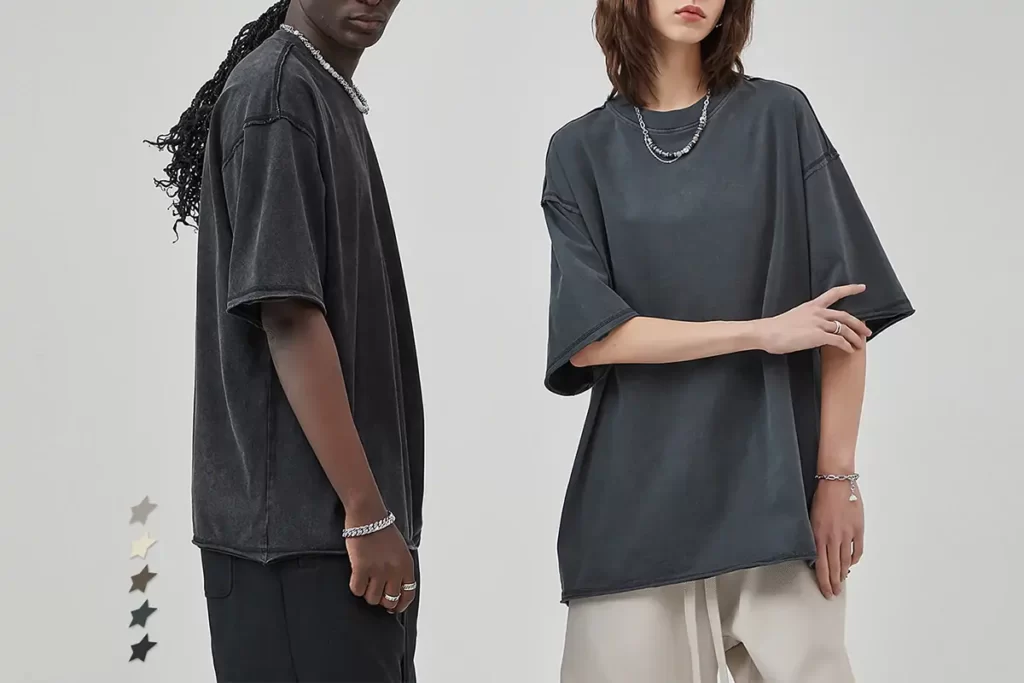Washing is a popular street fashion clothing processing technology, such as street, retro, and motorcycle clothing above. Washing can make products more outstanding. Let us understand the common 8 kinds of the washing process.
1. Garment Wash
Ordinary washing is ordinary washing, but we are familiar with the washing changed to mechanization. Its water temperature is 60°-90°C. Add a certain detergent, after about 15 minutes of ordinary washing, over water plus softener can make the fabric more soft, comfortable, more natural, and clean in the visual.

Usually, according to the length of washing time and the number of chemicals used, the general wash can be divided into general light wash, general wash, and general heavy wash. Usually, general light washes for about 5 minutes, general wash for about 15 minutes, and general heavy wash for about 30 minutes (this time is inaccurate). There is no obvious boundary between the three washing methods.
2. Stone Wash
Stone washing is adding a certain size of pumice in the washing water so that pumice and clothing grinding, grinding the water level in the tank with clothes fully soaked in the low water level so that pumice can be in very good contact with clothing. General washing or rinsing can be carried out before stone grinding, and rinsing can be carried out after stone grinding. According to the different requirements of customers, you can use yellow stone, white stone, AAA stone, artificial stone, rubber balls, and other washing to achieve a different washing effect. The washing cloth surface appears gray and old feeling. Clothing is slight to severely damaged.

3. Enzyme Wash
The enzyme is a cellulase. It can be at a certain PH and temperature, the structure of the fiber degradation so that the fabric can fade more gently, depilation (producing a “Peach skin” effect), and get a lasting soft effect. Stones can be used with or in place of stones. When used with stones, it is often called enzyme stone wash.

4. Destroy Wash
Damage washing refers to the clothing after pumice grinding and additives treatment, in which some parts (bone position, collar angle, etc.) have a certain degree of damage. Washing clothes will have a more obvious residual effect.

5. Snow Wash
The dry pumice is soaked in a potassium permanganate solution and then polished directly with clothes in a special rotary cylinder. The pumice is rubbed on the clothes to make the potassium permanganate oxidize the friction points away, causing the cloth surface to present irregular discoloration, forming a similar snowflake white spot.

Different materials can stir-fry different effects. Often appear is fried, fried snow is more uniform, soft, fried more coarse, rough!
6. Bleach Wash
To give the clothes a white or bright appearance and a soft feel, it is necessary to rinse the clothes by heating them to 60°C after ordinary washing with clean water and adding the appropriate amount of bleaching agent according to the depth of the bleaching color, 7-10 minutes to make the color matching board.

Rinsing can be divided into oxygen bleaching and chlorine bleaching. Oxygen bleaching is using hydrogen peroxide in a certain PH value and oxidation temperature to destroy the dye’s structure and achieve fading and whitening purposes. The general bleaching cloth will be slightly red. Chlorine bleaching uses the oxidation of sodium hypochlorite to destroy the structure of dyes, thus achieving the goal of fading. Chlorine bleach fade effect of rough, mostly used for indigo blue denim rinsing.
After bleaching the board, the water and residual chlorine should be neutralized by the sea wave to stop the bleaching, and then the bleaching is carried out after STONE grinding. It is called Bleach Stone Wash.
7. Moustache Effect
It is whiskers, but the term whiskers are more professional. Whisker is a type of hand brush. It is just ground into the shape of a cat’s whiskers.

8. Monkey Wash
Monkey Spray is when a potassium permanganate solution is sprayed onto a garment by a spray gun, causing a chemical reaction that causes the fabric to fade. Use The Potassium permanganate concentration and spray amount to control the degree of fading. From the effect of the point, the spray monkey fades evenly, and the surface layer inside the fade can achieve a strong fade effect.

It is important to note that the essential difference between Monkey Wash and sandblasting is that the former is chemical while the latter is physical. The sandblasting is only on the surface there is fading. You can see the physical damage to the fiber.
Conclusion
When operating the washing process, you need to pay attention to details, choose the right temperature, detergent, and mechanical action according to the fabric and washing requirements, and control the water quality and rinsing, dewatering, and other links to obtain good washing results. MGOO has a perfect garment washing treatment process and years of industry experience to help your products realize their ideas so that they are more popular and hot in the market. If you have any demand contact us at any time.

